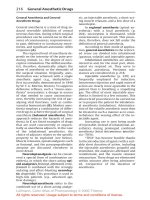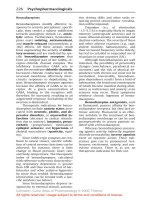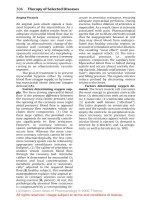Color Atlas of Pharmacology (Part 18): Drugs for the Suppression of Pain
Bạn đang xem bản rút gọn của tài liệu. Xem và tải ngay bản đầy đủ của tài liệu tại đây (508.42 KB, 10 trang )
Pain Mechanisms and Pathways
Pain is a designation for a spectrum of
sensations of highly divergent character
and intensity ranging from unpleasant
to intolerable. Pain stimuli are detected
by physiological receptors (sensors,
nociceptors) least differentiated mor-
phologically, viz., free nerve endings.
The body of the bipolar afferent first-or-
der neuron lies in a dorsal root ganglion.
Nociceptive impulses are conducted via
unmyelinated (C-fibers, conduction ve-
locity 0.2–2.0 m/s) and myelinated ax-
ons (A!-fibers, 5–30 m/s). The free end-
ings of A! fibers respond to intense
pressure or heat, those of C-fibers re-
spond to chemical stimuli (H
+
, K
+
, hista-
mine, bradykinin, etc.) arising from tis-
sue trauma. Irrespective of whether
chemical, mechanical, or thermal stim-
uli are involved, they become signifi-
cantly more effective in the presence of
prostaglandins (p. 196).
Chemical stimuli also underlie pain
secondary to inflammation or ischemia
(angina pectoris, myocardial infarction),
or the intense pain that occurs during
overdistention or spasmodic contrac-
tion of smooth muscle abdominal or-
gans, and that may be maintained by lo-
cal anoxemia developing in the area of
spasm (visceral pain).
A! and C-fibers enter the spinal
cord via the dorsal root, ascend in the
dorsolateral funiculus, and then syn-
apse on second-order neurons in the
dorsal horn. The axons of the second-or-
der neurons cross the midline and as-
cend to the brain as the anterolateral
pathway or spinothalamic tract. Based
on phylogenetic age, neo- and paleospi-
nothalamic tracts are distinguished.
Thalamic nuclei receiving neospinotha-
lamic input project to circumscribed ar-
eas of the postcentral gyrus. Stimuli
conveyed via this path are experienced
as sharp, clearly localizable pain. The
nuclear regions receiving paleospino-
thalamic input project to the postcen-
tral gyrus as well as the frontal, limbic
cortex and most likely represent the
pathway subserving pain of a dull, ach-
ing, or burning character, i.e., pain that
can be localized only poorly.
Impulse traffic in the neo- and pa-
leospinothalamic pathways is subject to
modulation by descending projections
that originate from the reticular forma-
tion and terminate at second-order neu-
rons, at their synapses with first-order
neurons, or at spinal segmental inter-
neurons (descending antinociceptive
system). This system can inhibit im-
pulse transmission from first- to sec-
ond-order neurons via release of opio-
peptides (enkephalins) or monoamines
(norepinephrine, serotonin).
Pain sensation can be influenced
or modified as follows:
¼
elimination of the cause of pain
¼
lowering of the sensitivity of noci-
ceptors (antipyretic analgesics, local
anesthetics)
¼
interrupting nociceptive conduction
in sensory nerves (local anesthetics)
¼
suppression of transmission of noci-
ceptive impulses in the spinal me-
dulla (opioids)
¼
inhibition of pain perception (opi-
oids, general anesthetics)
¼ altering emotional responses to
pain, i.e., pain behavior (antidepress-
ants as “co-analgesics,” p. 230).
194 Drugs for the Suppression of Pain (Analgesics)
Lüllmann, Color Atlas of Pharmacology © 2000 Thieme
All rights reserved. Usage subject to terms and conditions of license.
Drugs for the Suppression of Pain (Analgesics) 195
A. Pain mechanisms and pathways
Perception:
sharp
quick
localizable
Perception:
dull
delayed
diffuse
Descending
antinociceptive
pathway
Paleospinothalamic
tract
Neospinothalamic
tract
Prostaglandins
Local anesthetics
Reticular
formation
Opioids
Opioids
Anti-
depressants
Anesthetics
Gyrus postcentralis
Nociceptors
Cyclooxygenase
inhibitors
Inflammation
Cause of pain
Thalamus
Lüllmann, Color Atlas of Pharmacology © 2000 Thieme
All rights reserved. Usage subject to terms and conditions of license.
Eicosanoids
Origin and metabolism. The eicosan-
oids, prostaglandins, thromboxane,
prostacyclin, and leukotrienes, are
formed in the organism from arachi-
donic acid, a C20 fatty acid with four
double bonds (eicosatetraenoic acid).
Arachidonic acid is a regular constituent
of cell membrane phospholipids; it is
released by phospholipase A
2
and forms
the substrate of cyclooxygenases and
lipoxygenases.
Synthesis of prostaglandins (PG),
prostacyclin, and thromboxane pro-
ceeds via intermediary cyclic endoper-
oxides. In the case of PG, a cyclopentane
ring forms in the acyl chain. The letters
following PG (D, E, F, G, H, or I) indicate
differences in substitution with hydrox-
yl or keto groups; the number sub-
scripts refer to the number of double
bonds, and the Greek letter designates
the position of the hydroxyl group at C9
(the substance shown is PGF
2!
). PG are
primarily inactivated by the enzyme 15-
hydroxyprostaglandindehydrogenase.
Inactivation in plasma is very rapid;
during one passage through the lung,
90% of PG circulating in plasma are de-
graded. PG are local mediators that at-
tain biologically effective concentra-
tions only at their site of formation.
Biological effects. The individual
PG (PGE, PGF, PGI = prostacyclin) pos-
sess different biological effects.
Nociceptors. PG increase sensitiv-
ity of sensory nerve fibers towards ordi-
nary pain stimuli (p. 194), i.e., at a given
stimulus strength there is an increased
rate of evoked action potentials.
Thermoregulation. PG raise the set
point of hypothalamic (preoptic) ther-
moregulatory neurons; body tempera-
ture increases (fever).
Vascular smooth muscle. PGE
2
and PGI
2
produce arteriolar vasodila-
tion; PGF
2!
, venoconstriction.
Gastric secretion. PG promote the
production of gastric mucus and reduce
the formation of gastric acid (p. 160).
Menstruation. PGF
2!
is believed to
be responsible for the ischemic necrosis
of the endometrium preceding men-
struation. The relative proportions of in-
dividual PG are said to be altered in dys-
menorrhea and excessive menstrual
bleeding.
Uterine muscle. PG stimulate labor
contractions.
Bronchial muscle. PGE
2
and PGI
2
induce bronchodilation; PGF
2!
causes
constriction.
Renal blood flow. When renal
blood flow is lowered, vasodilating PG
are released that act to restore blood
flow.
Thromboxane A
2
and prostacyclin
play a role in regulating the aggregabil-
ity of platelets and vascular diameter (p.
150).
Leukotrienes increase capillary
permeability and serve as chemotactic
factors for neutrophil granulocytes. As
“slow-reacting substances of anaphy-
laxis,” they are involved in allergic reac-
tions (p. 326); together with PG, they
evoke the spectrum of characteristic in-
flammatory symptoms: redness, heat,
swelling, and pain.
Therapeutic applications. PG de-
rivatives are used to induce labor or to
interrupt gestation (p. 126); in the ther-
apy of peptic ulcer (p. 168), and in pe-
ripheral arterial disease.
PG are poorly tolerated if given
systemically; in that case their effects
cannot be confined to the intended site
of action.
196 Antipyretic Analgesics
Lüllmann, Color Atlas of Pharmacology © 2000 Thieme
All rights reserved. Usage subject to terms and conditions of license.
Antipyretic Analgesics 197
A. Origin and effects of prostaglandins
Kidney
function
Labor
Fever
Thromboxane Prostacyclin
Cyclooxygenase
Arachidonic acid
Pain stimulus
e.g., PGF
2!
Prostaglandins
e.g.,
leukotriene A
4
involved in
allergic reactions
Leukotrienes
Vasodilation
Phospholipase A
2
Lipoxygenase
[ H
+
]
Mucus
production
Capillary permeability
Nociceptor
sensibility
Impulse
frequency in
sensory fiber
Lüllmann, Color Atlas of Pharmacology © 2000 Thieme
All rights reserved. Usage subject to terms and conditions of license.
Antipyretic Analgesics
Acetaminophen, the amphiphilic acids
acetylsalicylic acid (ASA), ibuprofen,
and others, as well as some pyrazolone
derivatives, such as aminopyrine and
dipyrone, are grouped under the label
antipyretic analgesics to distinguish
them from opioid analgesics, because
they share the ability to reduce fever.
Acetaminophen (paracetamol) has
good analgesic efficacy in toothaches
and headaches, but is of little use in in-
flammatory and visceral pain. Its mech-
anism of action remains unclear. It can
be administered orally or in the form of
rectal suppositories (single dose,
0.5–1.0 g). The effect develops after
about 30 min and lasts for approx. 3 h.
Acetaminophen undergoes conjugation
to glucuronic acid or sulfate at the phe-
nolic hydroxyl group, with subsequent
renal elimination of the conjugate. At
therapeutic dosage, a small fraction is
oxidized to the highly reactive N-acetyl-
p-benzoquinonimine, which is detoxi-
fied by coupling to glutathione. After in-
gestion of high doses (approx. 10 g), the
glutathione reserves of the liver are de-
pleted and the quinonimine reacts with
constituents of liver cells. As a result,
the cells are destroyed: liver necrosis.
Liver damage can be avoided if the thiol
group donor, N-acetylcysteine, is given
intravenously within 6–8 h after inges-
tion of an excessive dose of acetamino-
phen. Whether chronic regular intake of
acetaminophen leads to impaired renal
function remains a matter of debate.
Acetylsalicylic acid (ASA) exerts an
antiinflammatory effect, in addition to
its analgesic and antipyretic actions.
These can be attributed to inhibition of
cyclooxygenase (p. 196). ASA can be giv-
en in tablet form, as effervescent pow-
der, or injected systemically as lysinate
(analgesic or antipyretic single dose,
O.5–1.0 g). ASA undergoes rapid ester
hydrolysis, first in the gut and subse-
quently in the blood. The effect outlasts
the presence of ASA in plasma (t
1/2
~
20 min), because cyclooxygenases are
irreversibly inhibited due to covalent
binding of the acetyl residue. Hence, the
duration of the effect depends on the
rate of enzyme resynthesis. Further-
more, salicylate may contribute to the
effect. ASA irritates the gastric mucosa
(direct acid effect and inhibition of cy-
toprotective PG synthesis, p. 200) and
can precipitate bronchoconstriction
(“aspirin asthma,” pseudoallergy) due
to inhibition of PGE
2
synthesis and over-
production of leukotrienes. Because ASA
inhibits platelet aggregation and pro-
longs bleeding time (p. 150), it should
not be used in patients with impaired
blood coagulability. Caution is also
needed in children and juveniles be-
cause of Reye’s syndrome. The latter has
been observed in association with feb-
rile viral infections and ingestion of
ASA; its prognosis is poor (liver and
brain damage). Administration of ASA at
the end of pregnancy may result in pro-
longed labor, bleeding tendency in
mother and infant, and premature clo-
sure of the ductus arteriosus. Acidic
nonsteroidal antiinflammatory drugs
(NSAIDS; p. 200) are derived from ASA.
Among antipyretic analgesics, di-
pyrone (metamizole) displays the high-
est efficacy. It is also effective in visceral
pain. Its mode of action is unclear, but
probably differs from that of acetamino-
phen and ASA. It is rapidly absorbed
when given via the oral or rectal route.
Because of its water solubility, it is also
available for injection. Its active metab-
olite, 4-aminophenazone, is eliminated
from plasma with a t
1/2
of approx. 5 h.
Dipyrone is associated with a low inci-
dence of fatal agranulocytosis. In sensi-
tized subjects, cardiovascular collapse
can occur, especially after intravenous
injection. Therefore, the drug should be
restricted to the management of pain
refractory to other analgesics. Propy-
phenazone presumably acts like meta-
mizole both pharmacologically and tox-
icologically.
198 Antipyretic Analgesics and Antiinflammatory Drugs
Lüllmann, Color Atlas of Pharmacology © 2000 Thieme
All rights reserved. Usage subject to terms and conditions of license.









